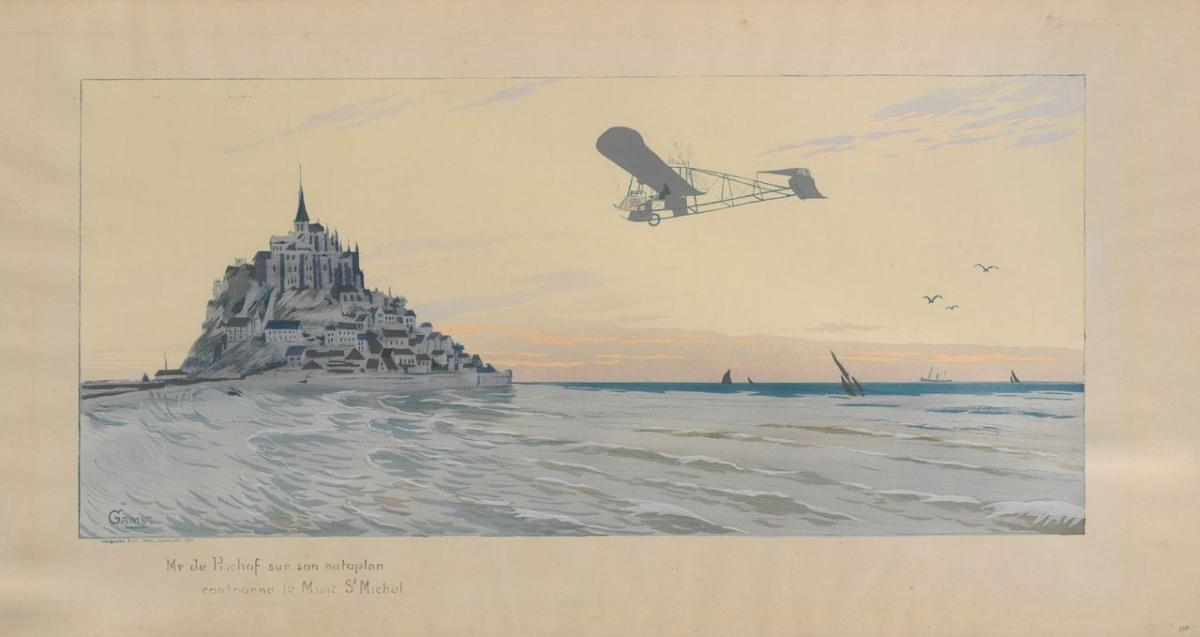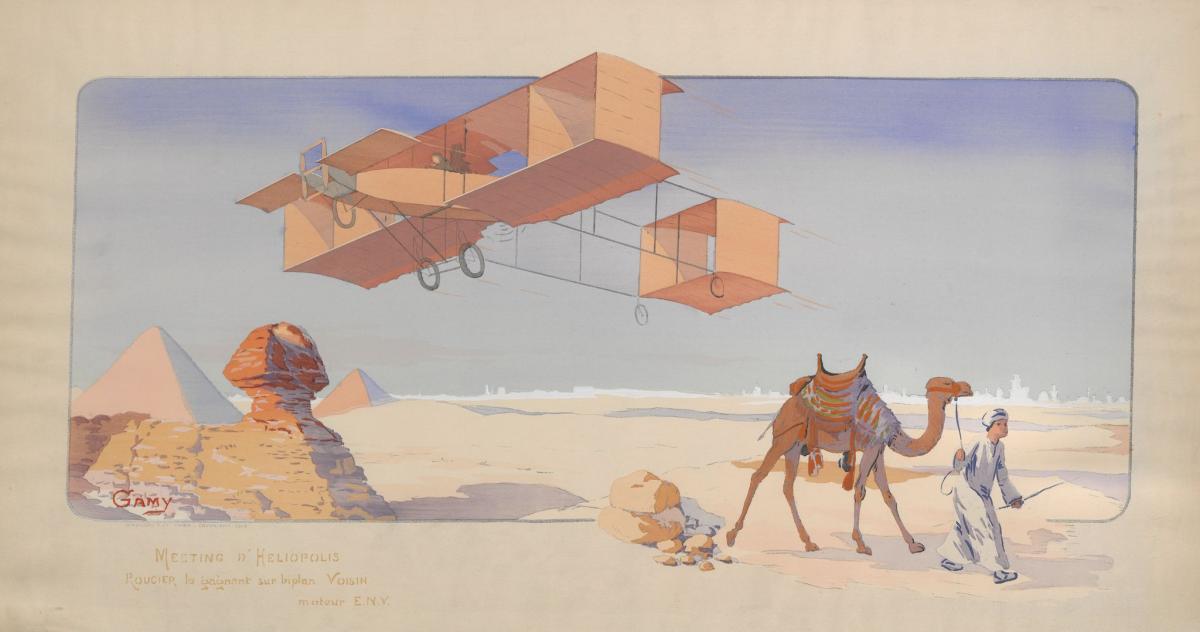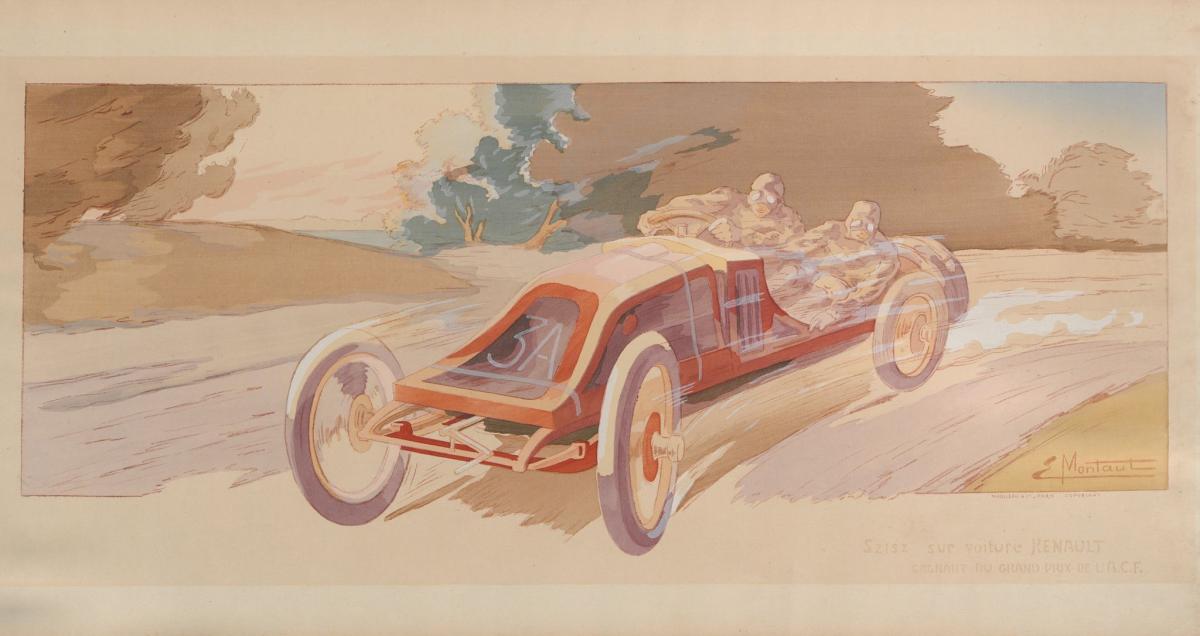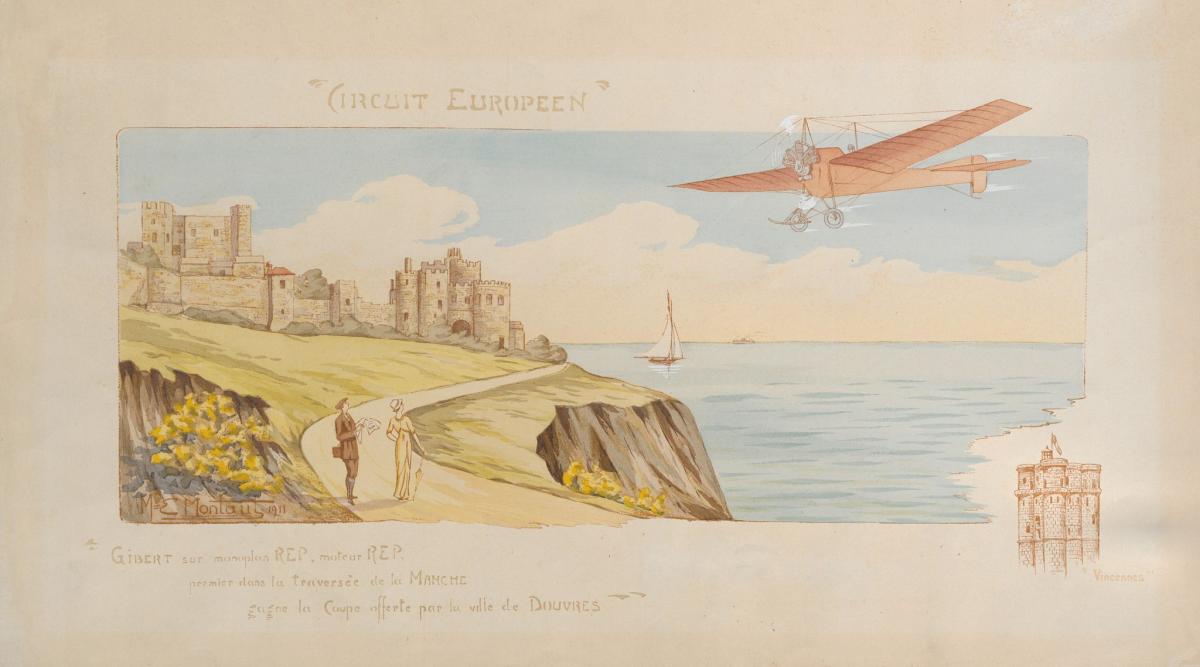 Sitting in my office staring out at a cloudless sky on a beautiful spring afternoon, my thoughts wandered to the days of early flight. Fancying myself an early aviator, I saw myself soaring past Mont St. Michel over choppy water like Alfred de Pischof on his glider (see right) or winning the Bendix Trophy like Louise Thaden in her Beech C17R Staggerwing biplane. Fortunately for me, I only need to look to Hagley's own collections to see scenes like these captured in colorful detail in the lithographic prints of French artists Ernest and Marguerite Montaut.
Sitting in my office staring out at a cloudless sky on a beautiful spring afternoon, my thoughts wandered to the days of early flight. Fancying myself an early aviator, I saw myself soaring past Mont St. Michel over choppy water like Alfred de Pischof on his glider (see right) or winning the Bendix Trophy like Louise Thaden in her Beech C17R Staggerwing biplane. Fortunately for me, I only need to look to Hagley's own collections to see scenes like these captured in colorful detail in the lithographic prints of French artists Ernest and Marguerite Montaut.
Between the aeronautical collection of Lammot du Pont and the automotive collections of Z. Taylor Vinson, Hagley owns more than thirty hand-painted lithographs showcasing the excitement of early automobile racing and aviation. The Montaut prints feature these marvels of modernity contrasted with pastoral landscapes, historical landmarks and ruins, and scenes of nature.

One of my favorite prints shows the early aviator Henri Rougier racing in the Grande Semaine d'Aviation at Heliopolis in 1910 (see right). This was the first aviation meet held on the African continent. In the image, a great machine whizzes past the Great Sphinx, almost clipping it, while a man with his camel plod on in the opposite direction, oblivious to the clash of modern and ancient civilizations playing out behind him. The plane is the clear star of the image, centered and looming large over the symbol of ancient Egypt below. The pilot, barely visible in silhouette, takes a backseat to the heroics of the Voisin biplane.
The scene is so fantastical that we can conveniently forget that the Great Sphinx is actually 240 feet long and 66 feet high while the Voisin biplane was a mere 44 feet long with a wingspan of 35 feet. We also don’t mind that the Sphinx is nowhere near where the aviation meet was being held. It is easy to get swept away into the adventure on display, although such glorified scenes belie the colonialist narrative they reinforce, showing European invention as inheriting, and triumphing over, the legacy of ancient Egypt.
Unfortunately, there is little concrete information available about the artists of these remarkable prints. The consensus is that Ernest Montaut, born in France in 1879, began his business in Paris and highlighted identifiable automobiles in his art. He sadly passed away at the early age of 31 in 1909 from appendicitis, and his wife Marguerite continued the business. Marguerite seems to have shifted gears toward the sky, focusing on aeronautical themes. It is inferred that prints signed with "GAMY" (an anagram of Magy, short for Marguerite) and "M. Montaut" are her works. The Montauts’ firm hired other artists to assist in the business. The printmaking was a time-consuming process. The outline of each print was made with standard lithographic techniques, but then the color was applied by hand. This makes for subtle variations in each version of a single print.

The Montauts used a variety of techniques to capture the excitement of the early automotive and aeronautical age. Ernest Montaut is often credited with originating the technique of adding speed lines behind machines. The Montauts also borrowed from photographic techniques, making portions of the image appear out of focus while the automobile or airplane zooms through space.[1] In many of the images, the highlighted vehicle escapes the frame of the print, as if not even the artist can slow down these machines. Historian of gender and technology Julie Wosk argues that Marguerite "not only celebrated the feats of male fliers but also created telling images contrasting the allure of aviation with women's conventional roles." In some of Marguerite's works, "the woman gazes up at this new world of aviation, a world that soon would offer women a way to transcend the burden of their traditional gender roles."[2]

An art gallery in France is currently preparing a catalog raisonné (a published compendium of all known works of an artist) of the Montauts' work,[3] so perhaps we will learn more about these elusive artists soon. Until then, we can content ourselves with the art they produced. In addition to the ones featured in this article, the rest may be viewed here in the Hagley Digital Archives.
[1] Tubbs D. B. 1978. Art and the Automobile. Guildford Surrey: Lutterworth Press.
[2] Wosk Julie. 2001. Women and the Machine : Representations from the Spinning Wheel to the Electronic Age. Baltimore: Johns Hopkins University Press.
[3] Les Galeries Sarto. "Ernest Montaut (1878 - 1909)." Accessed April 2023. https://www.sartoart.com/en/ernest-montaut
Angela Schad is the Head of Reference Services at Hagley Museum and Library.
